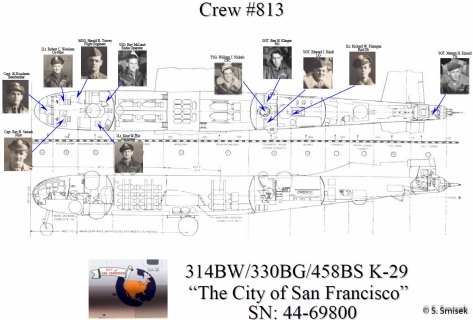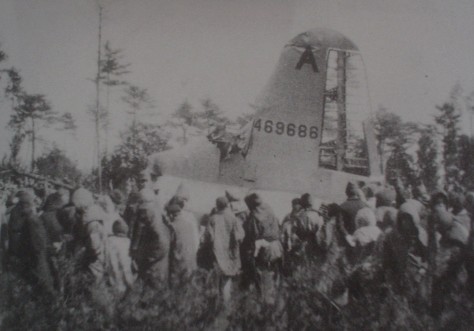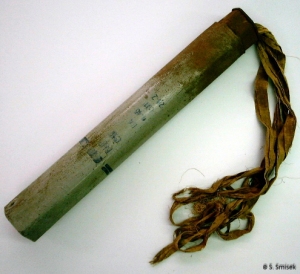
The Firebombing of Tokyo – Epilogue
War is hell.
Vile.
Scars are left on those who had to endure the horror…
Those who witnessed it…
Those who fought in it…
But then hopefully there is a healing.
Perhaps it will take a generation or two.
But it will happen.

Perhaps one will never forget… but one can forgive.
Perhaps is it wrong of me – a person who never endured war – to say it so simply. Forgive.
But I have witnessed forgiving with Old Man Jack… Mr. Johnson…
Warriors have forgiven and tried to move on with their life in spite of nightmares for the rest of their lives.
Civilians, too.
The result is endearing friendship. The same USAF that bombed Japan assisted thousands of stranded Japanese civilians after the tsunami. The world has benefited but at the cost of the sanity of single souls so many decades ago.
Captain Ray B. Smisek
On Sept. 2, 1945, Captain Ray Smisek once again made a round trip flight to Tokyo.

This time, it was as a member of one of the great air armadas ever assembled in history. Over 300 carrier based Navy planes and hundreds of B-29s. MacArthur rightfully wanted to make an impression upon the Japanese people by ordering a huge flyover Tokyo Bay and the USS Missouri, where the formal surrender documents were signed. (They were to fly over at the moment of the signing but were late, upwards of ten minutes. MacArthur apparently whispered to General Hap Arnold of the USAAF something to the effect of, “Now would be a good time, Hap,” with respect to his missing armada.)
It was the crew’s 21st mission. They were going home.

______________________________
In Part 1, son S. Smisek said of his father that he hated to kill anything – even bugs. That was his character.
Capt. Ray Smisek returned home to his parents after the war and tried his hand in the Los Angeles real estate market; he also worked as a cook in a restaurant. He must have made one heckuva Sauerkraut, one of his favorites.

But… Ray Smisek had met a young woman while he and a back-seater were on a cross-country training flight in 1942. They were flying from Greenville, Mississippi when the BT-13 trainer developed engine trouble. To make matters worse, there was a bad storm. Not swell conditions when you’re training to be a pilot. Fortunately, the clouds miraculously parted and a small town below was bathed in forgiving sunlight. He said he did a barrel roll and dove through the break in the clouds. It turned out to be a rural airport in Springfield, MO (now known at the Springfield-Branson National Airport).

S. Smisek explained to me that his father rarely, if ever, talked about his time at war while he was growing up. That was very typical, you see. His son wrote very eloquently:
When I was growing up, he never spoke much of his time during the war. When asked about those times, I could see a sullenness come over his face, then he would most often ask me another question just to change the subject. In those rare exchanges when he would answer, he made it very clear that he desired no recognition for what he had done. He desired no contact with his fellow comrades, felt no honor for the devastation he had helped cause, and amazingly to me, felt no affection whatsoever for the incredible aircraft which had brought he and his crew back safely from so many missions over so many horrible places.
He, along with the rest of these brave young men, was an ordinary and yet an extraordinary human being – a person who offered some of his life’s most vital years in the service of his country, and who sacrificed his ambitions so that countless others would have the freedom to accomplish theirs.
Raymond B. Smisek was diagnosed with a very aggressive cancer in 1989 and passed away at home, surrounded by his family, in August 1990. He was just 70 years old. His son believes his father also suffered from another cancer – one related to unhealed scars from war. His son said they were cancers of the soul and spirit, much more damaging than those of the body. His wife – the singer in the big bands of the ’40s – passed away in 2001.
____________________________________
Please visit his son’s tribute to the men of the 330th Bombardment Group at www.330th.org. For the sake of the families of the WWII airmen, S. Smisek has researched and brought many of the pieces together of what it was like for their fathers at war. Through his website and in a sterling triumph several years ago, S. Smisek played a key role in coordinating the meeting of a Japanese gentleman living in Canada with a B-29 pilot from his father’s squadron. Seventy years earlier, the Japanese gentleman was in Kumagaya Japan as an eight year old, running from the bombs being dropped from the pilot’s aircraft. The two finally met and it was moving and emotional moment per S. Smisek. For an article of the meeting, please click here.
____________________________________
Aunt Eiko

There was no escaping bombardment for Aunt Eiko, even after moving to Fukui slightly inland from the Japan Sea; the US Navy shelled their farming neighborhood heavily. She also vividly remembers a small group of high school aged Japanese soldiers relaxing at the nearby beach and still cries inside knowing their fate.
Preceded by my mother, Aunt Eiko and grandma returned to Tokyo sometime in mid-September to find it in shambles. People were living in lean-to’s, she said, and running water still had not yet been re-established in devastated areas. Food was a tremendous daily hurdle. She cannot recall when but she remembers it was such a relief when MacArthur began rationing out beans and drinkable water…but it was American beans. Still, the beans were appreciated.


But their greatest savior surviving the first few months after war’s end was another relative – an American. An American of Japanese descent that is. Taro Tanji was born in Livingston, CA but was drafted out of the Amache War Relocation Center in Colorado by the US Army. He became a member of the famed Military Intelligence Service.
He arrived in Tokyo at war’s end as part of the US 8th Army’s Occupation Force. Through his intelligence connections, he was able to track down Aunt Eiko and family in a suburb called “Toritsu Daigaku”. Some of it had miraculously escaped burning.
Driving up in his US Army jeep, he stayed at their house every weekend. Each time, he would bring a duffle bag filled with C-rations, instant coffee and American cigarettes for my Grandfather (which he reluctantly accepted – funny story). Yes, Aunt Eiko ate the Spam and deviled ham. Taro managed to get in a good word and found both Aunt Eiko and my mother jobs at the PX.

Things were tough until the early 50’s. Dogs as pets were still rare as they also needed to be fed…but Aunt Eiko wanted dearly to achieve one of her dreams – to have a dog.
And so she did… She named him “Prince”, or “Puri” when you shorten “Pu-ri-un-su” pronounced in Japanese. She loved him until he passed away in 1968. She was devastated, of course. I think Puri was an escape from the war’s ugliness for her.
She met Paul Sakuma sometime in the late 60’s; he was a Hawaiian born Sansei who was also drafted by the US Army into the Military Intelligence Service by the US Army. He was attached to the 720th MP Battalion to serve as a translator. He told a funny story to Aunt Eiko where the MPs frequently raided certain types of “houses”… You know… GI’s were prohibited from “fraternizing with the enemy” so they would raid them. One time, there was a fellow MIS Nisei caught inside. He made sure the “howlies” couldn’t escape…but held the door open for the Nisei. After being discharged, he decided to stay in Tokyo to live and worked for the USAF as a civilian employee, using his knowledge of Japanese as a go-between.

They married but had no children – but a week before my first marriage in 1980, I got a phone call from Aunt Eiko in Tokyo. She was sobbing uncontrollably.
Uncle Paul had gone upstairs in their beautiful home he just had built for them after washing her car. He screamed, “Eiko!” It would be his last word; he suffered a massive heart attack and died, right there at the top of the stairs in his brand new home.
Soon after his death, Aunt Eiko immigrated to the US along with my grandmother. She became an US citizen about a dozen years ago.
In an irony, the country that bombed her city to ashes in 1945 bestowed upon her beloved husband Uncle Paul (as well as to Uncle Taro) the Congressional Gold Medal in 2010 for their service to the country. While both had passed away before the award, Aunt Eiko cried for happy when I surprised her with the medal. She said, “Even after all these years, Paul still brings me happiness.”


As for her childhood friends, she is all who remains now at 88 years of age, just like Old Man Jack. Her friend who was burned during the firebombings was one of the last to pass away. She was the tall girl standing behind Aunt Eiko atop the Asahi Newspaper Building on October 30, 1937 and shown here in 1963.
__________________________
A most sincere thank you to S. Smisek without whom this series would not have been possible. I wish him continued fortune with his 330th Bomb Group’s website, helping those descendants piece together their father’s contribution in World War II.

Previous parts can be found by clicking on the links below:
The Firebombing of Tokyo – Part 1
The Firebombing of Tokyo – Part 2

























































